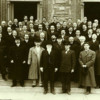In the 19th century, at the height of its early prosperity, Elmira, New York saw the building of quite a few sizable and impressive churches, many of them grouped at the city's center. The 20th century churches are a different story, but we'll get there, too.
The 19th century churches were mostly built by congregations whose leading citizens made their money from trade along the canal that linked the city to the Finger Lakes and the Erie Canal, from milling, manufacturing and other industries. These churches reflect mostly Protestant denominations; in that era Elmira's Catholic population was centered among workers in those industries, less wealthy, and building homes and churches a bit further away. These are a few of the still-impressive downtown churches.
One of the best-known and largest is the Park Church, which takes its name from being on the edge of Elmira's original downtown park, Wisner Park. The church was finished in 1876, replacing a smaller wooden church. The new larger church was necessary because of its popular and charismatic pastor, Thomas K. Beecher, younger brother of Henry Ward Beecher and Harriet Beecher Stowe. That's his statue in the picture a bit further up.
In its old building, it was a center of Abolitionist feeling and activity; the Park Street Church founders left the First Presbyterian Church in 1846 over its refusal to take a stand against slavery.

in its new building Mark Twain, Samuel Langhorne Clemens, was married by Beecher to a local woman, Olivia Langdon, whose parents were active in the church and in the Abolitionist movement. Twain is in this 1906 photo: recognize him?
As you look at the images of the Park Street Church above and below, you're likely to agree with the common description "highly eclectic," with its Gothic, Byzantine and Romanesque touches.
Just a few blocks further along Church Street from Park Church is Lake Street Presbyterian, which was founded in 1861 as Second Presbyterian. Like Park Street, it was founded by a group who split from First Presbyterian at the beginning of the Civil War. Its pastor died just before the building opened, so the dedication speech was made by Thomas K. Beecher.
You'd be forgiven for thinking church, but this is actually the home of Chemung County government offices!
Trinity Episcopal, is less than a block from Park Church, and is a bit older. The 1833 congregation moved into its impressive building in 1858, and chose more or less straight-up Gothic Revival, carried out in red brick. It's one of few churches around with a spire built the same as the body of the church.
Trinity also has a link with the Park Church; it started in an old schoolhouse on the site now occupied by Park; in 1836, with help from the wealthy Trinity parish in New York City, it built a small wooden church on that site and stayed there until the current building was finished.
Trinity also has an unusual-for-America vertical sundial.
Not all of Elmira's 19th century churches have fared as well, and First Baptist, across the park from the Park Church, is an example. Baptists were among the first white settlers in the area; a Methodist minister headed to the area in 1792 was warned to be wary of "bears, blizzards and baptists."
Over the years, the church that became First Baptist grew, built a large brick church in 1848, expanded it in 1875, and had to start all over after a fire. The present building was completed in 1892, and served a congregation of well over a thousand.
But in the late 20th century, the congregation, and its finances declined. In 2009, the building was 'decommissioned,' and later sold to a private developer. At present, it is empty, deteriorating, beautiful, and sad.
And now we come to two more recent additions to Elmira's religious community and architecture. And remember: If they seem small and sketchy, the big churches above were all started in small spaces by small groups. And if their religious bent seems a bit out of the mainstream, remember that the anti-slavery ideals of the Park Church founders were, too!
And, ensconced in a former grocery store, a church whose name speaks to its hopes, and whose decorations indicate an ecumenical message.


Comments (0)